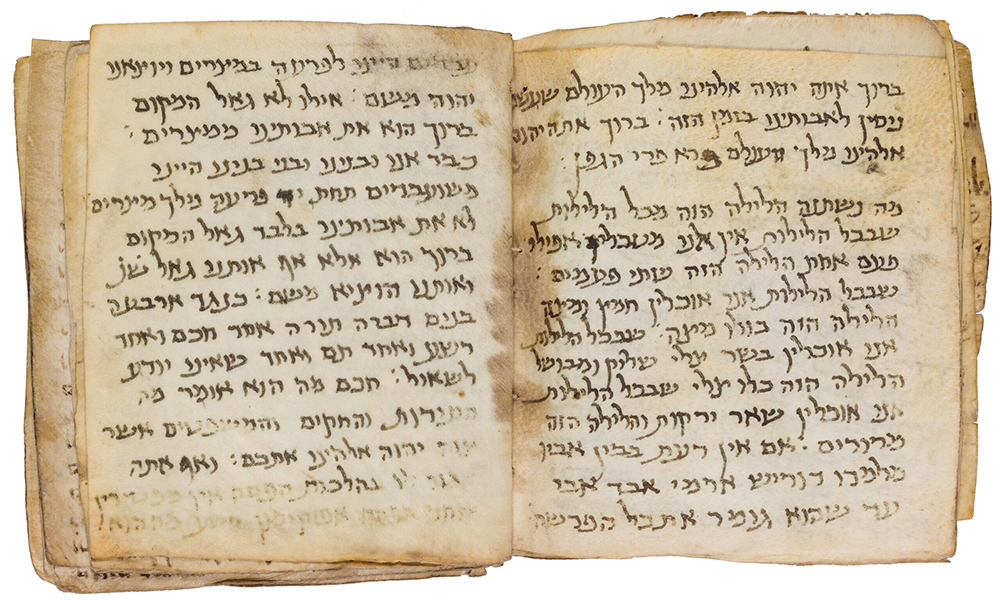|
Getting your Trinity Audio player ready...
|
By: Vita Fellig
A Hebrew manuscript, which experts have dated to the eighth century making it the earliest known such object, is on view in New York City after being the centerpiece of an exhibition in Washington, D.C., at the Museum of the Bible.
The Afghan Liturgical Quire, which is part of the Washington museum’s collection but which has uncertainty in its provenance history, is part of the show “Sacred Words: Revealing the Earliest Hebrew Book,” which opened on March 19 at the Jewish Theological Seminary Library in Manhattan.
Herschel Hepler, associate curator of Hebrew manuscripts at the Museum of the Bible, told JNS that the New York exhibition has some opportunities that were unavailable during the Washington installation. (Hepler was deeply involved in tracing the manuscript’s provenance and in a forthcoming scholarly volume about the object’s significance.)
“JTS was a natural partner for several reasons,” he told JNS. “It’s a historic library and institution deeply connected to Jewish cultural reconstruction post-World War II.”
“It has the largest collection of Jewish books and manuscripts in the United States, second only to the National Library of Israel,” he added. “It’s one of the most significant Hebrew manuscript collections in the world.”
The New York show will also give broader access to the Afghan Jewish community, many of whose members are based in the city and couldn’t make the trip to Washington, according to Hepler.
With Passover approaching, the manuscript is also part of a timely exhibit, as the curious object—which contains several different Jewish texts—contains part of the Haggadah. That section of the manuscript predates the previously oldest-known Haggadah by about two centuries, Hepler said.
“The JTS collection includes two of the next oldest Haggadot, both dating to around 1000 C.E., but the AQL, which is mysteriously oriented upside-down, could be 200 to 300 years older,” he told JNS.
“It’s fascinating to see the evolution of ‘Ma Nishtana’ and the long-forgotten opening blessings of the Seder, which can now be seen in this manuscript,” Hepler said.
“From 200 CE to 900 CE, which is known as the ‘silent period; for Hebrew manuscripts, we have very few surviving Jewish texts, and most of what we do have are fragments” he added. “But the AQL is intact and still bound as it was originally. That’s an extraordinary rarity.”
Discovered in the Bamiyan Valley of Afghanistan along the Silk Road, the manuscript passed through the hands of Afghan rulers, private collectors and scholars before being identified by the scholars involved in the show and enlisted by the Washington museum as the oldest known Hebrew book.
Museum of the Bible experts, including Hepler, conducted extensive research on the volume, and it was studied using radiometric dating, which found that the materials date back to the eighth century.
The manuscript, which is bound by string, also contains unique liturgical poems, called piyutim.
Jack Abraham, president of Congregation Anshei Shalom in Queens and the head of the Afghan Jewish community in New York, worked closely with the Bible Museum. He told JNS that the exhibit is an inspiring display of Mizrahi Jewish history.
“This is our heritage and inheritance,” he said. “Jews have been in Afghanistan for 2,500 years, but there are no more traces of us within that country anymore.”
“If no one finds an older book than this, then this is the mother of all Mizrahi prayer books and shows that everything Jewish originates from Mizrahi tradition,” he said. “The prayer book that exists today? It was compiled in Sura about 150 or 200 years after this one.”
‘We’ve carried this with us’
The AQL demonstrates that Mizrahi traditions serve as the root of the entirety of the Jewish religion, according to Abraham.
“This is our history and our DNA,” he said. “This book represents a key moment when oral traditions began to be written down, making prayers more complete and for me, this is an inspiration, because it takes us back and reminds us of where we come from.”
Abraham added that from the Babylonian exile until the present day, “generation after generation, we’ve carried this with us.”
“This book is 1,300 years old, which is exactly half the time since we were exiled 2,600 years ago. Think about that,” he said. “Half the time of our exile. That’s a powerful connection.”
David Kraemer, the librarian at JTS and a professor of Talmud and rabbinics, hopes that visitors will appreciate the diversity of Jewish history from the exhibit.
“There is something magical about being in the presence of a historically significant object—the oldest Hebrew book ever discovered,” he told JNS. “We hope that visitors will take a few minutes to experience the awe of seeing such an object.”
“Beyond that, this book, and the others that join it in the exhibit, tell the story of Jews in the East traveling, with others, along storied trade routes, all while preserving their customs and recording their prayers in different, new ways,” he said.
“We hope this will help visitors experience lost Jewish worlds, while appreciating the reality that Jews have, over the centuries, lived and created virtually everywhere,” he added.
(JNS.org)




